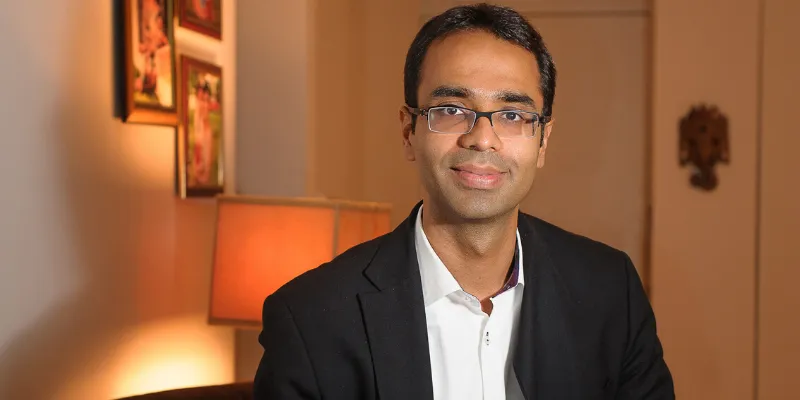[YS Learn] How WhiteHat Jr got its first cheque of $1.3M and how it found a $300M exit with BYJU’S
Looking to raise your first round of funding? But do not know what works and what doesn’t? Here are some stories on how startups were able to clinch the deal. This time we look at WhiteHat Jr and their journey to being acquired by BYJU’S for $300 million.
The journey of WhiteHat Jr is unique. The startup has been in the news ever since edtech unicorn acquired it for $300 million. Founded in 2018 by former Discovery Networks CEO Karan Bajaj, WhiteHat Jr offers AI courses to children aged six to 14 years. The Mumbai-based edtech startup aims to empower children so that they view themselves as creators.
WhiteHat Jr has been revenue positive, with 84 percent teachers under the age of 35 who are earning between Rs 50,000 and Rs 1.5 lakh a month. The ongoing ramp-up is to match the growing base of students across multiple countries including India, the US, Canada, the UK, Australia, and New Zealand.
Karan had started with initial funding of $1.3 million from Nexus Venture Partners and Omidyar Network India. He graduated from Birla Institute of Technology in 1999 and IIM-B in 2002, and worked for corporates like Kraft, P&G, and BCG. Speaking of his journey and learnings, he tells YourStory,
“In my case, I think the convention was broken a little bit. The old convention was that you created a prototype, got user traction, then you use that user traction to create a working product. That is the classic Silicon Valley model where you take the angel funding from friends and family, create a product, and then approach the investors.”

Karan Bajaj, Founder and CEO of WhiteHat Jr.
Looking beyond convention
When Karan approached the investors to raise over a million dollars, they were a little surprised that he was pitching without a working product. As he explains, what helped was that India as a market had changed and the investment thesis for the country too had changed from 2015.
“If there was a qualified founder who had a history of building businesses, they would get funded based on their idea,” says Karan.
Speaking about his pitching experience, Karan says,
“All I had was a PowerPoint presentation, a vision and backing from some early friends and family who tested my idea. With that, I presented a plan and got $1.3 million from Nexus and Omidyar without actually even registering the company.”
Solving a problem
Karan had started WhiteHat Jr to solve a personal problem. In an earlier conversation with YourStory, he said,
“As a father of two daughters, I was aware of the massive shifts caused by technology in every aspect of life, and wanted my kids to be at the centre of creating technology versus consuming it. So, I read about early childhood coding from MIT and TUFTS."
"Interestingly, the research indicated that kids who code go through a fundamental psychological shift when they use the fundamentals of logic, sequence, structure, and algorithmic thinking to create tech products such as games, animation, and apps. They start to think of life as a playground for experimentation and creation,” he added.
When Karan approached the investors, he had a relevant problem that needed a solution. The education system was yet to focus on skilling from a younger age.
Learn to articulate your story right
Karan explains that it is important to articulate your story in a clear manner. He says he had a clear presentation of 15 slides that articulated the roadmap for the company.
“There is not much more to that than being able to articulate your story to the last detail. Articulate both your vision and the execution plan on how you go about executing it. There is not much more science behind it. Create a very compelling presentation, good data backing the presentation on how big the market is, how your pricing structure will work, what’s the gross margin, what’s net margin, and what would be the customer acquisition cost based on historical benchmarks and historical categories,” says Karan.
He adds that the first time you meet investors, you should have completely thought through things, end to end. He says it was a huge leap of faith for the investors to give him credit.
“I can take a lot of credit but for them, I did not have a CTO in a tech company. I had no tech background, never coded anything. I had no education background. So, it was a big leap of faith,” he adds.
Use data to back your story
Karan adds that everything he said was backed by market data to create a compelling and detailed story. He says that while everybody has an idea, converting that idea into a very detailed last-mile execution needs a plan.
“The investor knows that all of those numbers will change once you start executing, but it shows the depth of thinking in the founder and that gives them the confidence that if the money is given, it won’t be spinning in circles, and the founder will go to the last mile to execute it," he says.
"I had everything down to the last detail – the customer acquisition cost, what will be the lifespan value as a result of that, what will be the customer retention; I had the whole financial model worked out, along with the presentation,” he explains.
While every founder is passionate, it is important to get into the last mile of the numbers. This, Karan adds, makes the founder’s grip on the business quantifiable.
Write a strong intro mail
Karan says, “My personal experience is that the intro email has to be a very strong anchor. For example, I just wrote two sentences in my intro email. ‘I am Karan. I am the CEO of Discovery India and I have built businesses from zero to a billion dollars in three geographies. I have written three bestselling novels and I always see things through.’"
"That line was powerful – ‘I always see things through’. So, it was very evident if you read my two lines that when I think of a novel, I will write it, complete it and make it a bestseller,” he quips.
Translating that into business terms, Karan wanted to convey that he will take care of the business and create it. That email got several responses. Karan had, in fact, written cold mails and hadn’t sought out any contacts from his IIM alumni network.
He looked at the venture capitalists' profile and connected with them on a simple email or LinkedIn message. And all of them responded. He explains that as a person, he doesn’t ask for favours or much help, and likes to do things himself. So Karan knew he had to write something compelling.
“It is very hard to not respond to an email from someone who is saying that I have written three bestselling novels and take ideas to the finishing point. And I have scaled businesses from zero to a billion in three geographies. So, whatever is your core reason to believe that you will turn an idea to a business, you should have it very clearly articulated. So, I think this is the specific advice that I give to people,” says Karan.

Shrey Shah, one of the coders at WhiteHat Jr
See if you want to dilute in later stages
While most founders say that taking an exit can be a tough call, Karan says it was the easiest decision for him. When Byju Raveendran, Founder and CEO of BYJU’S, reached out to him on WhatsApp for a meeting, Karan knew that this would be a game-changer. And the call wasn’t hard to make.
Speaking of WhiteHat’s acquisition, he says, “When you raise funding, you dilute your stake and get a new board member. I was raising $15 million. So, I would have got one or maybe two board members. I would have a five-member board and diluted my stake in the company. In parallel, I have a one-member board now with whom I have a vision to match. There is no conflict at all. He is also a founding board member. So, he knows the ups and downs of being able to crack a business model.”
He adds that it is important to have the same vision and energy to drive outcomes, an inside-out knowledge, and knowing how tough it is to get it completely correct.
Have you got tri-factor satisfaction?
The next factor is that you need to get the tri-factor where the acquiree, the acquirer and the investors are satisfied. It is very hard to get that right. Karan explains,
“In our case, it was good because the company had $150 million revenue run rate when it was acquired and $300 million was a good bargain for the acquirer because it was a 2x multiplier. From my vantage point, it was fair because there is a company which is merely one year old in terms of revenue generation and they have lived through all ups and downs. So, it was very right for the acquirer.”
The team also had to dilute a little. The founder and the ESOP holders had a significant stake in the company because Karan had only gone for two rounds of funding and that too, minor funding. He explains,
“When I started the company, it was valued at $6 million. So, they made 50x return on their investment in barely 15 months or so. If I had got one more round, my proportion would be diluted. There would be more board members. Each of those board members would have a certain objective. Then you have to wait for that exit to happen which makes investors happy."
"At the stage, for the investors to be happy, you need to have a revenue run rate which makes the valuation of the company so high that you will have to find a very particular acquirer who would want to pay that kind of valuation. So, you need to know what the perfect state is. I feel that this was a great state to be in,” he adds.

(R-L) Venkat Patnaik, Hirranya Rajani, Shaurya Sharma - coders at Whitehat jr
Be prepared to weather the storm
Karan says when you are in the middle of scaling the business, you also are raising funds. But when an acquisition conversation starts, the funding conversations stop. But that doesn’t mean the capital consumption stops.
“You are running out of funds that you need to run the business. It is a trying time. So, you know that if the acquisition falls through, then the business will be in a bit of trouble because it has to restart the funding conversation in a time when it is consuming the capital. So, I think it is hard for people to understand why it is such a trying time – because you have to stop one process to focus on the other,” says Karan.
What helped was WhiteHat Jr having a revenue run rate of $150 million and clean books. Karan says the due diligence process didn’t take more than 10 days. They were able to reconcile every account, every spend and the detail that was made. He says,
“Legally and financially, your books should be clean. At our stage of maturity, we were only 15-18 months in. People fall on these parameters. So, I would say, that is the more practical. The more intangible point is that you just have to roll with it."
"Having an acquisition conversation alongside a funding conversation in parallel with scaling the business is very intense and stressful because if the acquisition falls through, the business will have to be dug out of that hole. So, you have to keep a very calm mind. Keep your focus on the business. Keep scaling the business,” he adds.
Keep your eye on the operations
Karan adds that every stakeholder involved is trying to find and invest in a good business. It is important that the founder doesn’t shift their focus from the operations. If the business continues to operate well, the risk of acquisition falling through or funding not happening is reduced. If the business starts to flounder because you are not focused, then everything comes under question.
“Will the acquirer go through the commitment? Will the investors come back if the acquisition does not go through? But if the business is good, all of these things go away. So, in my head, I was always very focused — ever since I started the company — in making sure that the business remains very strong," Karan examines.
"Even during fundraising, I have always been very clear that I do only one or two investor meetings a day and not more than that. I was clear that more 80 percent of my time should always go towards running the business. And a good business will always attract the best investor,” he concludes.
Edited by Kanishk Singh


![[YS Learn] How WhiteHat Jr got its first cheque of $1.3M and how it found a $300M exit with BYJU’S](https://images.yourstory.com/cs/2/a9efa9c02dd911e9adc52d913c55075e/Imagehhhc-1599660982436.jpg?mode=crop&crop=faces&ar=2%3A1&format=auto&w=1920&q=75)
![[YS Learn] 10 reasons why things aren’t as chaotic as they seem to be](https://images.yourstory.com/cs/2/a9efa9c02dd911e9adc52d913c55075e/Fact-fulness-1599576508123.png?fm=png&auto=format&h=100&w=100&crop=entropy&fit=crop)
![[YS Learn] How founders can deal with everyday struggles and anxiety that come with the job](https://images.yourstory.com/cs/2/a9efa9c02dd911e9adc52d913c55075e/Everyday-struggle-1599482935364.png?fm=png&auto=format&h=100&w=100&crop=entropy&fit=crop)
![[YS Learn] Moglix founder Rahul Garg on getting marquee investors like Ratan Tata, Accel on board during early days](https://images.yourstory.com/cs/2/a9efa9c02dd911e9adc52d913c55075e/oieJyBFBlMFnCyJ-1599389844731.jpg?fm=png&auto=format&h=100&w=100&crop=entropy&fit=crop)
![[YS Learn] 4 key lessons startups can learn from Zappos for high team productivity](https://images.yourstory.com/cs/2/a9efa9c02dd911e9adc52d913c55075e/800x400-01-1599148668707.png?fm=png&auto=format&h=100&w=100&crop=entropy&fit=crop)




